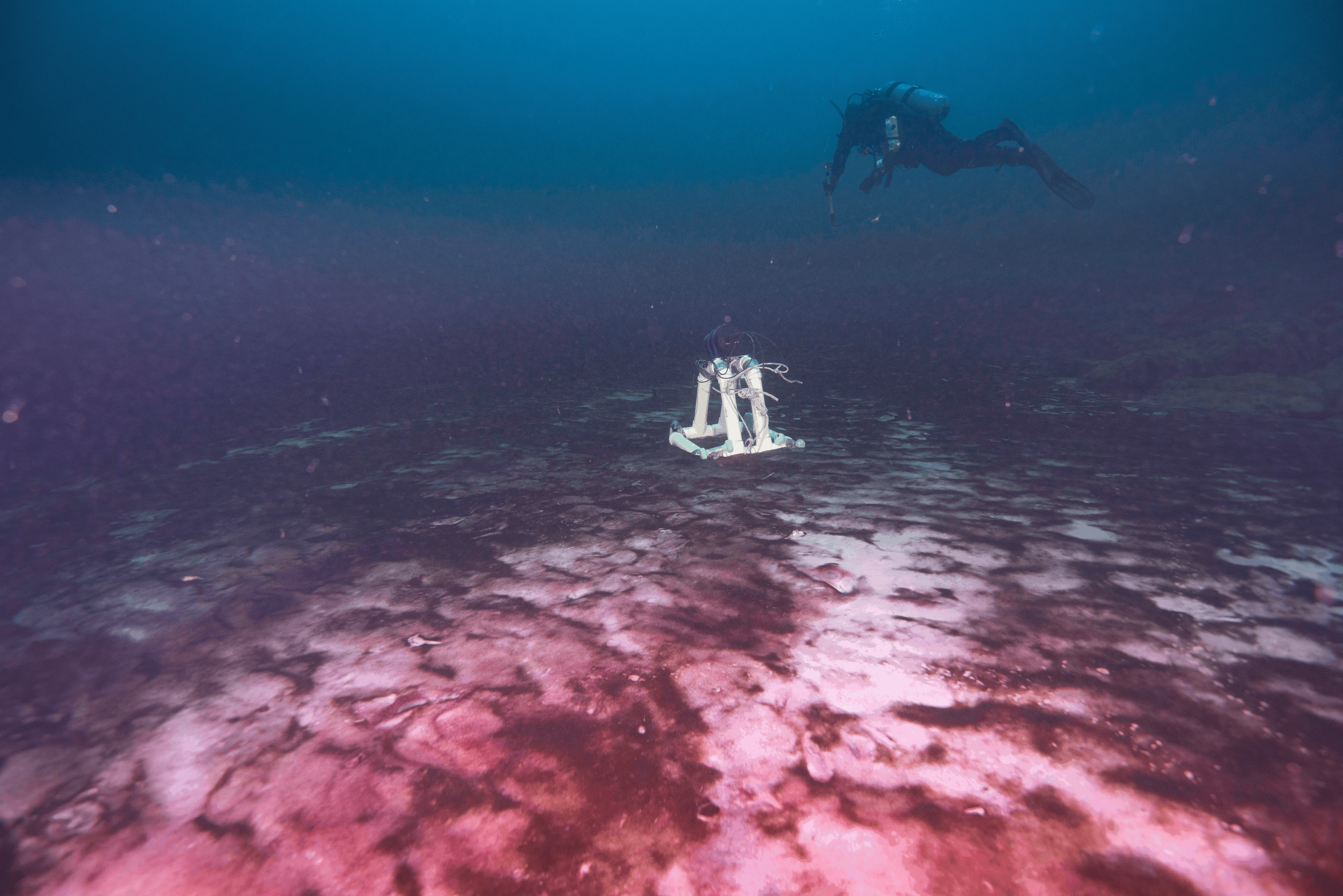 ©2020 Biological and Chemical Oceanography Data Management Office.
©2020 Biological and Chemical Oceanography Data Management Office.Funded by the U.S. National Science Foundation
NSF Award Abstract:
Modern-day microbial mats living on the bottom of sinkholes underneath Lake Huron experience an oxygen-poor, sulfur-rich environment resembling life on early Earth. These mat worlds are dominated by motile filaments of microbes that variably use sunlight and chemicals in their daily routines and offer opportunities for discovering novel microorganisms and ecosystem processes. Recently, complex patterns of daily vertical migration has been observed in the field, suggesting different microbes migrate vertically to the surface of the mat during daylight and nighttime. This project is unraveling the who, why and how of daily microbial migration through integration of microscopy, cultures, molecular approaches, and process rate measurements in response to changing gradients of light, sulfide and oxygen over the day-night cycle. This project places the vertical migration of microbial mats into a broader geobiological context through comparisons with other globally distributed cyanobacterial mat systems such as terrestrial springs and ice-covered Antarctic lakes. Furthermore, the diverse and versatile sinkhole mats may serve as a useful working model for robotic exploration of similar life in extraterrestrial waters like that of Jupiter's Europa or Saturn's Enceladus. This project is generating compelling student projects, attracting public imagination, and fueling active collaboration between two predominantly undergraduate institutions and a National Marine Sanctuary.
The functioning of cyanobacteria under sulfidic, low O2-conditions is a major gap in our understanding of Earth's oxygenation in the past. Recently, time-lapse images of diel vertical migration (DVM) were collected revealing alternating waves of vertically migrating photosynthetic and chemosynthetic filaments that followed daily fluctuating light in microbial mats in Lake Huron's sinkholes; observations corroborated with intact mats under simulated day-night conditions in the laboratory. Such synchronized diel movement, might have played a critical role in optimizing photosynthesis, chemosynthesis, carbon burial, and oxygenation during the Precambrian. This project is evaluating the taxa involved in DVM and is probing geobiological controls on DVM under low-O2, sulfidic conditions using macro- and microscopic imaging, physico-chemical microprofiling, culturing, genetics, and allelopathic studies. Three central issues are being addressed: (1) what taxa are responsible for the DVM? (2) how and why do they perform DVM? and (3) what are the ecosystem consequences of DVM community and activity synergies? The project is revealing specific microbial populations, metabolic pathways, and geochemical processes that underpin mat biogeochemistry over the diel cycle. Studying microbial communities that have regular and measurable daily rhythms in processes that can also be tracked at micrometer scales yields an unprecedented view of the molecular underpinnings of microbial mat biogeochemistry and lays the foundation for future studies aimed at re-defining the role of autotrophic communities in ancient seas and modern ecosystems.
This award reflects NSF's statutory mission and has been deemed worthy of support through evaluation using the Foundation's intellectual merit and broader impacts review criteria.
Logo photo credit:
Diver image of microbial mats in Middle Island Sinkhole, Lake Huron. Photo credit: Phil Hartmeyer, NOAA-NMS
| Dataset | Latest Version Date | Current State |
|---|---|---|
| Cyanobacterial and diatom samples collecteced between April and September 2022, and sequenced for metabarcodig of 16S and rbcL. | 2023-10-19 | Final no updates expected |
| Diatom cultures used to generate DNA reference library from samples collected from sites in Alpena, Michigan and Palm Coast, Florida between July 2021 & 2022. | 2023-10-17 | Final no updates expected |
| Cyanobacteria cultures used to generate DNA reference library from samples collected from sites in Alpena and Monroe, Michigan and Palm Coast, Florida between May and June 2022. | 2023-10-17 | Final no updates expected |

Lead Principal Investigator: Bopaiah Biddanda
Grand Valley State University (GVSU)
Principal Investigator: Dale Casamatta
University of North Florida (UNF)
Co-Principal Investigator: Sarah Hamsher
Grand Valley State University (GVSU)
Contact: Bopaiah Biddanda
Grand Valley State University (GVSU)
Technician: Anthony Weinke
Grand Valley State University (GVSU)
DMP_OCE-2046958_Biddanda_etal.pdf (186.58 KB)
01/28/2021